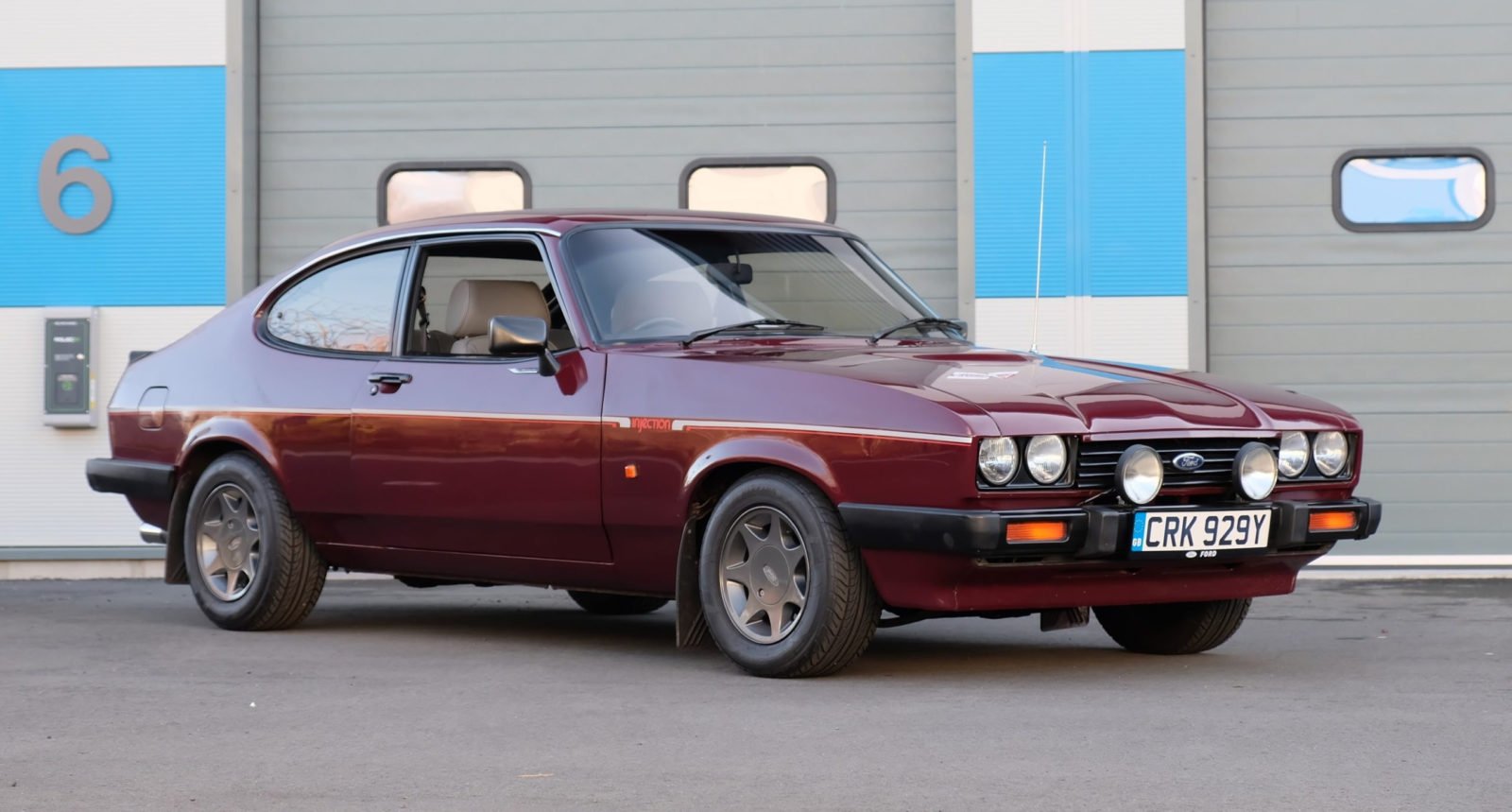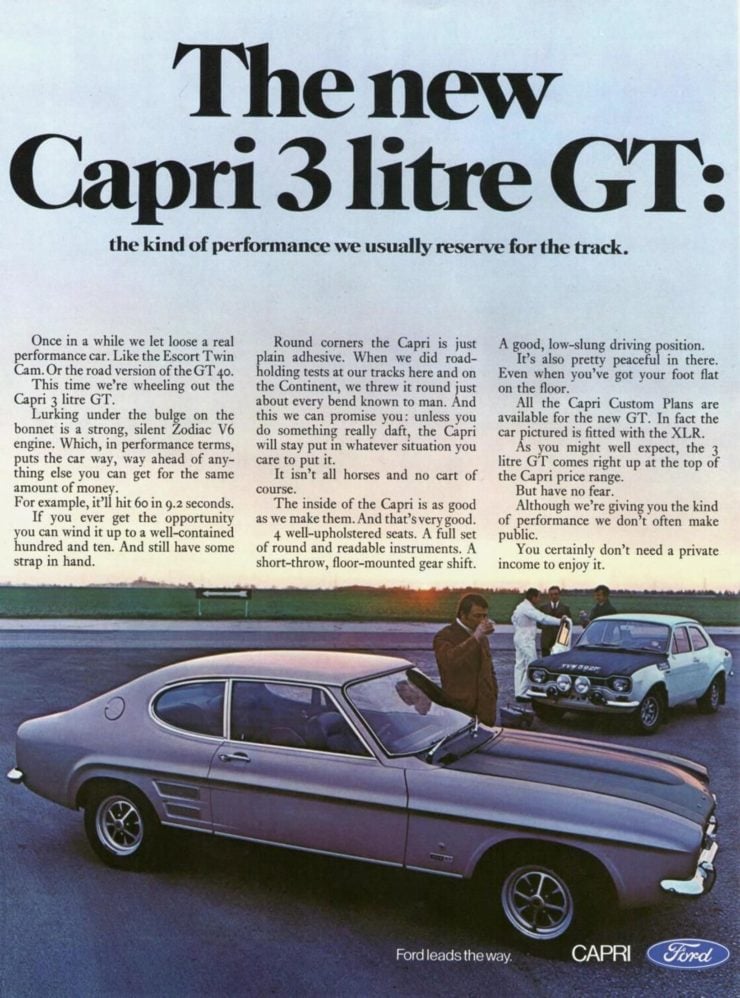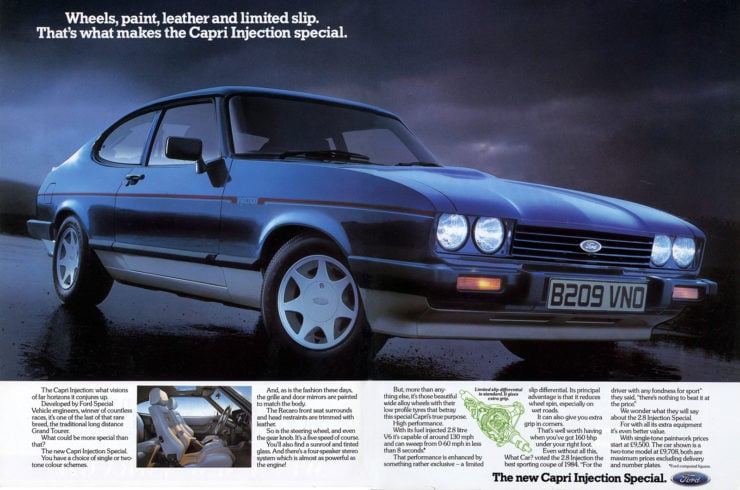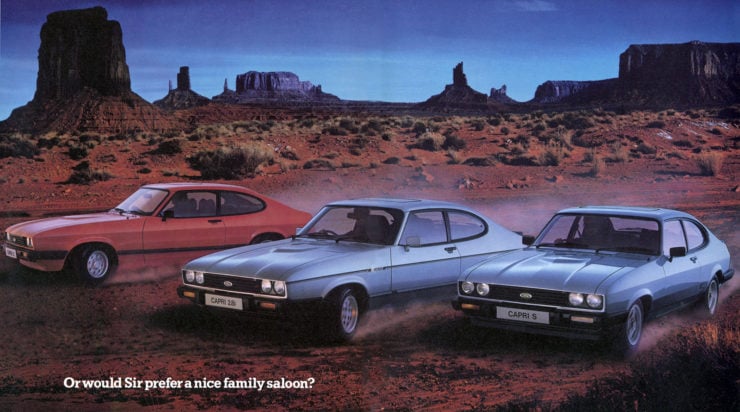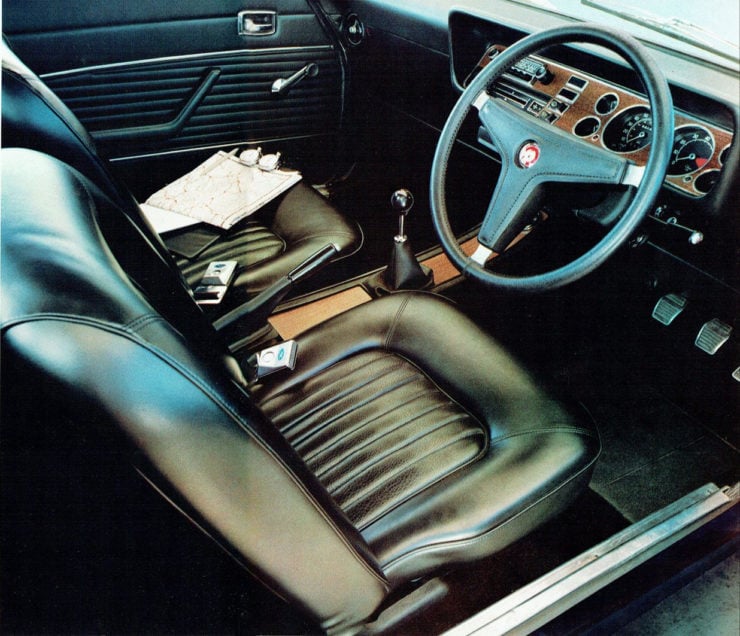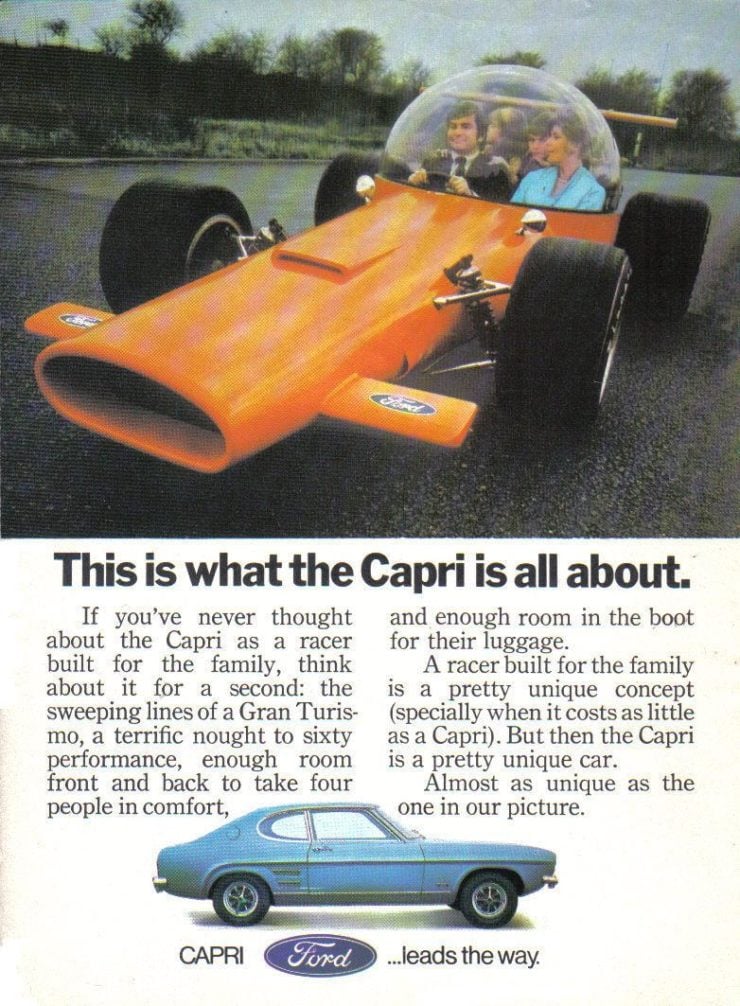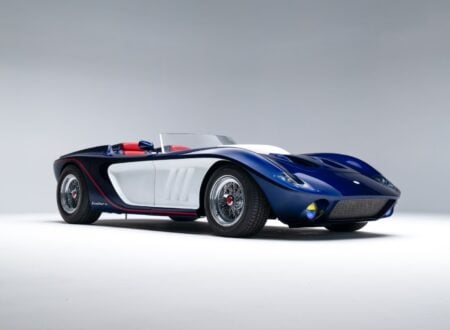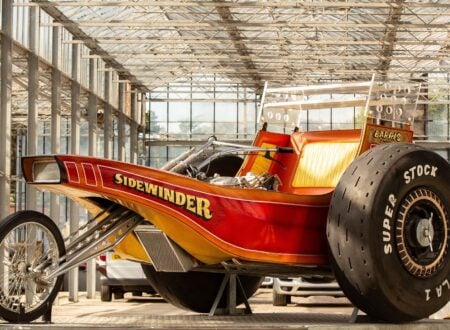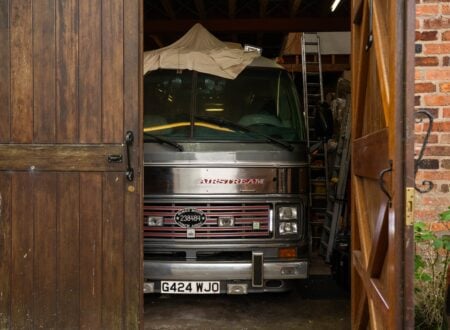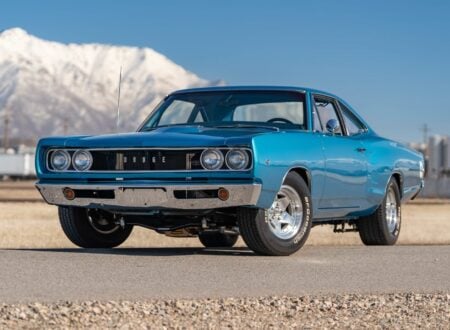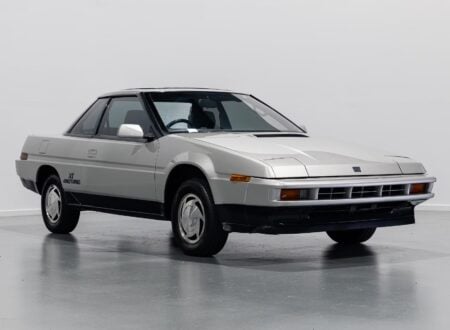The Ford Capri was created to become Ford’s “Pony Car” for the British and European markets – it was to be a mini Ford Mustang, a Ford performance car with European characteristics.
Ford wanted to call this new performance model the Ford Colt to keep in the horse related theme of the North American market Ford Mustang. This was not to be however as Japan’s Mitsubishi Corporation already owned the name “Colt” as applied to cars. So Ford were forced to think of something else and they settled on the name “Capri”, named after the island off Italy’s Sorrento Coast which is popular with the rich and fashionable.
Fast Facts: Ford Capri
- The Ford Capri was designed to be a car for the family man who wanted a sports car, but needed 2+2 seating and a decent amount of trunk (boot) space.
- The car was intended to be a European equivalent to the Mustang and was to wear the name “Colt”. However Japanese car maker Mitsubishi already owned the rights to the Colt name as applied to automobiles.
- The Capri was based on the successful Ford Cortina which had a strong sporting legacy.
- Early in the Capri’s production the high performance Capri RS2600 won the European Touring Car Championships both in 1971 and 1972 establishing the car’s sporting credentials.
- The Capri was in production for eighteen years from 1968-1986.
The Car You Always Promised Yourself
Back when the Ford Capri was first introduced in the late 1960’s Ford’s advertising for the car used the slogan “The car you always promised yourself”. Back then the first person I knew who purchased a new Ford Capri was a good friend who we’ll call “Martin” for our story although of course that was not his real name.
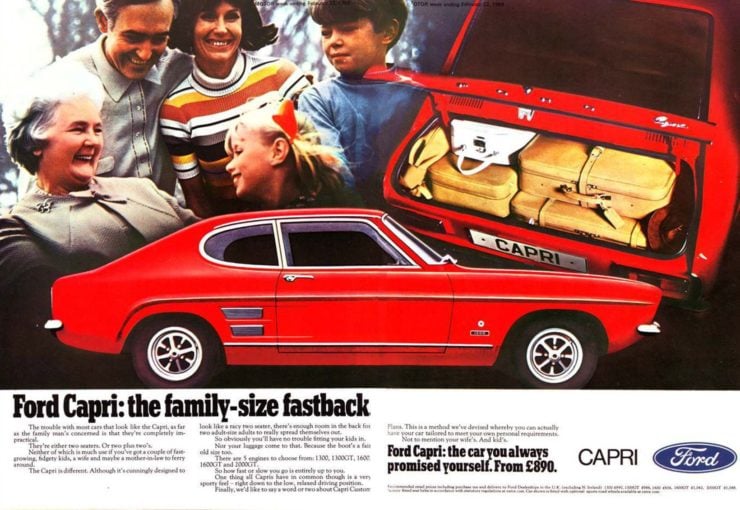

Martin was married to a wonderful wife and they had two young daughters. He was also the contented owner of a 1938 MG VA saloon.
He was very fond of his MG VA and was completely unperturbed by the fact that it did not have seat belts nor did it have synchromesh on either first or second gear of its four speed gearbox. The art of the double de-clutch was something that Martin had mastered and thus he enjoyed the challenge of driving the car – but his wife did not.
The ladies of Martin’s family got together and worked diligently to persuade him that his beloved MG VA was no longer a suitable car for transporting his family and so it needed to be sold to the good home of a collector so the family could have a safe and comfortable new car to ride around in.
He was reluctantly persuaded and so the MG VA was sold and he finished up at a Ford dealership in a rather grumpy mood. So grumpy in fact that when the salesman approached him with a cheery “would you like to buy a car sir” Martin snapped back “I haven’t bought a car since they stopped making cars!”
Martin emerged from the Ford dealership the owner of a beautiful pristine white Ford Capri and he learned to appreciate it. His wife was over the moon – it was the car she had always promised herself.
Europe’s Pony Car
The Ford Capri was originally intended to be called the Ford Colt – a name which would have been appropriate as it was intended to be Europe’s equivalent of the American Ford Mustang. As it turned out Japanese car maker Mitsubishi had an established model that also used that name and so, despite Ford’s efforts, they were unable to use it.
Ford then decided to name this new car “Capri” after the island off the Italian Sorrento coast, which is a Mecca for the rich of Europe and America. That name had previously been used for the British Ford Consul Capri which was a totally different car to the new Capri.
The Consul Capri was made from 1961-1964 and could be had in a GT version fitted with a 1,498 cc Cosworth inline four cylinder engine with a 9:1 compression ratio, a revised cylinder head with enlarged exhaust valves, aluminium inlet manifold, four branch exhaust manifold, and a twin-choke Weber carburettor. Of interest is that this car was the first Ford to be dubbed with the “GT” name worldwide.
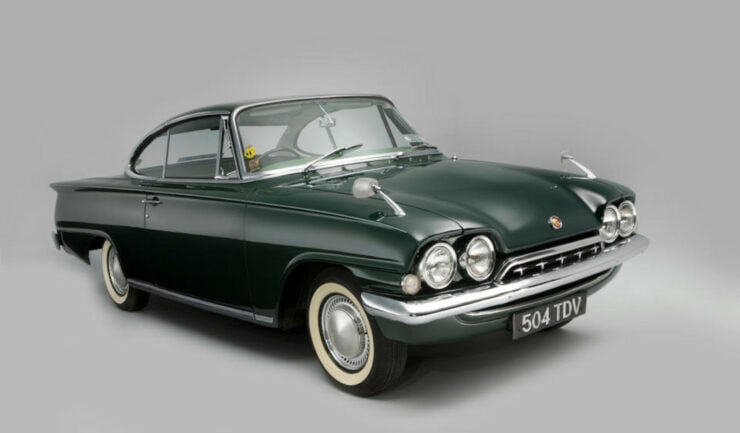

The Ford Capri that was to become Europe’s “Pony Car” was designed by Philip T. Clark who was also involved in the creation of the American Ford Mustang, and Uwe Bahnsen of Ford Germany. Budget constraints led to this new car being based on the Ford Cortina, which was not a bad thing as the Cortina had proved to be a popular car that had acquired quite a collection of sporting credentials. So the technology that underpinned the new Capri was tested and proven.
While the Capri was in development there were those in the motoring press who were of the opinion that the Capri was based on a Cortina floorpan: some even went so far as to describe the Capri as “a Cortina in drag”. This was in actuality not the case as there were significant differences such as in the suspension mounting points and axle location rods. These changes being necessary to achieve the low slung ride height desired to compliment the car’s sporting aspirations.
Ford Capri Mark I: 1968 – 1973
The Mark I Ford Capri was designed to be sold across Britain and Europe and so the base car was created to be able to be made in versions that were affordable to buy and economical to run, and also to be made in versions that offered a variety of performance and feature levels to suit as wide a variety of buyers as possible. So whether a customer was trading in his 1938 MG VA for modern family transport to keep the ladies of his household happy, or seeking to satisfy the performance lust of his inner Mr. Hyde, there would be a Ford Capri to satisfy those aspirations, and budget.
Production of the Capri was to be done simultaneously at the Halewood Ford factory in Britain, which is near the city of Liverpool, and the Ford plant in Cologne, Germany. The versions built in Britain being based around engines and drive train components common to the British market and those in Cologne fitted with engines and drive train components common to the German and European market.
Cars for the British market were installed with the Ford Kent 1.3 and 1.6 litre inline four cylinder engines as basic: and then subsequently the 2.0 litre Ford Essex V4, and towards the end of 1969 the Mr. Hydes were finally satisfied with the creation of the Ford Capri 3000 GT packing the 138 hp Essex V6, which turned every drive in the Capri into an adventure.
The Cologne built cars were installed with the Ford Taunus V4 engine in 1.3 litre, 1.5 litre, and 1.7 litre versions as basic: and then the Ford Cologne 2.0 litre. The desires of the European Mr. Hydes was finally satisfied by the creation of the Ford Capri 2300 GT whose dual barrel carburettor gave its V6 engine a crisp 123 hp with which to keep up with the traffic on the autobahn. Not exactly a BMW but still pretty exciting.
As the years of production advanced the Capri began to be sold in markets beyond Britain and Europe: construction began in Australia in 1969 using a mix of 40% Australian made components and 60% imported.
The Capri was also sold in South Africa installed with the Kent four cylinder 1.6 litre engine and the Essex 2.0 litre V6. Of special note was the special made by Basil Green Motors in Johannesburg who started out installing the 3.0 litre Essex V6, but not satisfied with that proceeded to cheekily squeeze nothing less than a Ford Windsor 302 cu. in. V8 into the lightweight Capri creating something seriously exciting: something that would enable a driver to escape a charging rhinoceros with relative ease.
The Capri was also exported to Japan where the conservative regulations and a conservative Japanese culture did not result in anything like the Basil Green South African version.
Into the 1970’s the Mark I Capri was treated to a “facelift” which resulted in some cosmetic changes and the phasing out of the Ford Kent four cylinder engines, replacing them with the American Ford Pinto ones.
As Ford embarked on its competition campaign with the Capri they created the Capri RS2600. This car etched the Capri name into the annals of racing history by winning the European Touring Car Championships both in 1971 and 1972.
The Capri RS2600 was developed for competition and was fitted with a specially built Cologne V6 with Weslake cylinder heads and Kugelfischer fuel injection, a custom suspension. a competition oriented close ratio gearbox, ventilated disc brakes, alloy wheels, and lightened bodywork.
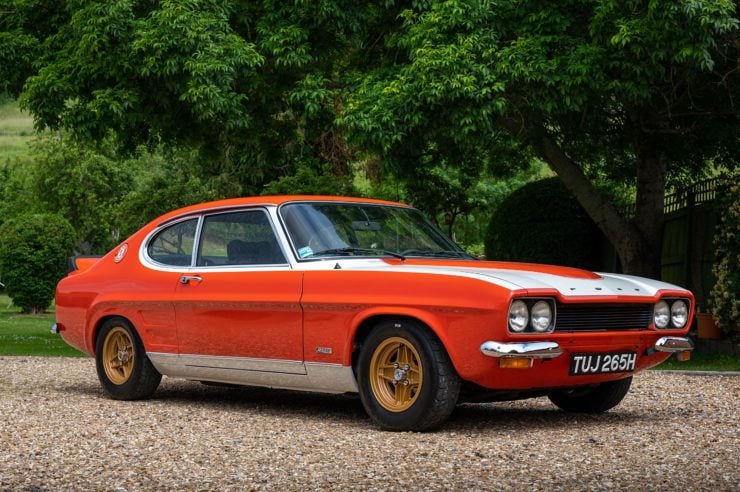

The European market was treated to a new performance version in the form of the RS 3100 which was fitted with a 3.1 litre (3.098 cc) version of the Essex V6 and using the same dual barrel Weber 38-DGAS carburettor. This engine delivered a useful 148 bhp at a conservative 5,000 rpm, making keeping up with the Jones’s on the autobahn an easy task.
The RS 3100 was significantly modified with the rear suspension being altered to move the rear suspension mountings outward necessitating body changes to accommodate the rear wheels with their negative camber.
The RS 3100 became the basis for the racing version which was homologated for the above three litre class of Group 2 competition for 1974.
For the US market from 1973 the Capri had to be fitted with large rubber covered bumpers to comply with US DOT regulations that mandated bumpers that would withstand a 5 mph impact without damage.
Ford Capri Mark I Specifications:
Body:
Length: 168.5 in (4,280 mm). Width: 64.8 in (1,646 mm). Height: 50.7 in (1,288 mm). Wheelbase: 100.8 in (2,560 mm). Weight: 2,053 lb (931 kg) – 2,522 lb (1,144 kg).
Suspension, steering and Brakes:
Front: MacPherson struts with anti-roll bar. Rear: Live axle with leaf springs and short radius rods. Telescopic shock absorbers.
Steering: Rack and Pinion.
Brakes: Discs at the front, drums at the rear, For the RS 2100 ventilated discs at the front.
Transmission:
Four speed manual with synchromesh on all gears.
Ford Capri Mark II: 1974 – 1978
Although the Mark I Capri was proving to be a popular car Ford decided that it needed a refreshing in terms of its looks and features. The base concept of the Mark I had been conceived as a European Mustang, presenting a long sleek bonnet/hood to enhance its sporting style. But for the Mark II Ford decided they would enlarge the interior space by shortening that long Mustang like hood/bonnet to give the car a more practical look and feel.
Ford’s designers managed the delicate balancing act between giving the car a new image while retaining a look that made it instantly recognizable as a Capri.
In keeping with the car’s improved interior space the Mark II was also fitted with a hatchback to provide more easy access to the rear luggage space, and to keep up with the fact that the hatchback style was becoming increasingly popular.
Engines were the 1.3 litre 54 hp Crossflow inline four for those seeking miserly fuel economy. The world had been subjected to the surging fuel prices invoked by the 1973 Fuel Crisis resulting in many people being rather more interested in fuel economy than standing to 60 mph and top speed figures.
The next engine was the 1.6 litre version of the four cylinder Crossflow producing 71 hp and providing rather better driveability and excellent fuel economy. There was also a GT version of this 1.6 litre engine delivering 87 hp, and then a 2.0 litre Crossflow with 98 hp. The Crossflow engine had earned for itself an excellent reputation for driving performance and reliability.
In addition to the four cylinder engine line-up there were two V6 options: a Cologne 2.3 litre 106 hp, and the Essex 3.0 litre 138 hp version.
Transmissions were either the all synchromesh four speed manual or the Ford C3 three speed automatic (which was available with all engines except, sensibly, the 1.3 litre four).
Sales of the Mark II were perhaps a bit disappointing, although the car deserved better. It seems to have lost the attractiveness it once had as a dedicated sporty model as it morphed into something that smacked of being a compromise between family car and sports sedan. The Mark II was indeed a better car – but somehow just didn’t attain the level of “cool” that its predecessor did.
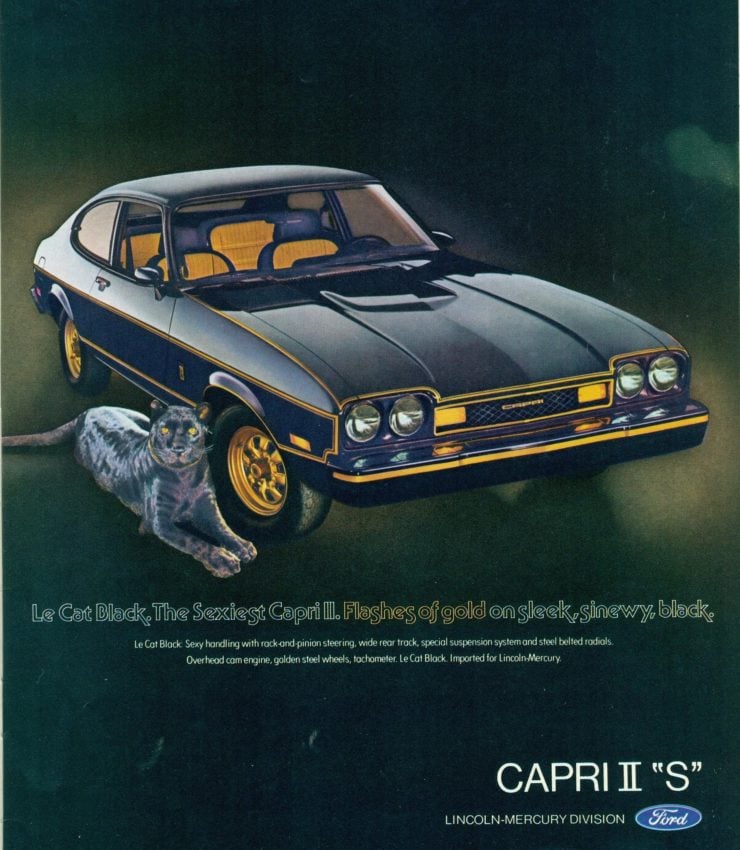

To infuse a bit of “coolness” into the Mark II a fashionable Ghia version was created intended to appeal to the trendy stylish customer. It came with an automatic transmission as standard with the 3.0 litre V6.
In an effort to regain some of the Mark I’s performance image Ford created the “John Player Special” version painted in a special livery to mimic the John Player Special Formula 1 racing cars. These were made only in black or white and were fitted with eye-catching gold wheels.
Manufacturing of the Mark II at Britain’s Halewood factory was ended in 1976 with all production being re-located to the Cologne plant in Germany.
The car was exported to the United States badged as the Mercury Capri.


The Series X and GP1 were special models that can be found in both Mark II and later Mark III cars being made from 1977-1980. These interesting cars were fitted with fibreglass wide body kits made by Fibresports and were fitted with upgraded ventilated front disc brakes, an “anti-dive kit” which included Bilstein gas shock absorbers at the rear with Bilstein struts at the front, single leaf springs at the rear and a Salisbury limited slip differential.
The V6 engines for these specials included a 168 hp V6 for the GP1 which had a Weber 40 DFI5 carburettor, enlarged inlet valves, and ported cylinder heads.
The Series X Capri models had the engine power from the GP1 boosted to 185 hp with the engine breathing through triple dual throat Weber 42 DCNF carburettors.
Ford Capri Mark II Specifications:
Body:
Length: 166.9-169.8 in. (4,240–4,313 mm). Width: 66.9 in. (1,698 mm). Height: 53.4 in (1,357 mm). Wheelbase: 100.7 in (2,559 mm).
Weight: 2,149.5-2,513.3 lb (975-1,140 kg)
Suspension, steering and Brakes:
Front: MacPherson struts with anti-roll bar. Rear: Live axle with leaf springs and short radius rods. Telescopic shock absorbers.
Steering: Rack and Pinion.
Brakes: Discs at the front, drums at the rear.
Transmission:
Four speed manual with synchromesh on all gears.
Three speed automatic transmission.
Ford Capri Mark III: 1978 – 1986
The Mark III Ford Capri was a revised and re-styled Mark II. Motivation for its creation was not only Ford’s desire to give the model a fresh look and feel, but also because the markets were changing as other manufacturers brought out new models that served to alter people’s perceptions of the sort of car they wanted.
Ford (Europe)’s Head of Design Uwe Bahnsen, who had worked with Philip T. Clark to create the Mark I Capri, was the one to perform what was to be the last upgrading of the style of the car: and not only the Capri but across the full European model range.
The Capri Mark III was given a simplified look with improved aerodynamics. The large rectangular Hella headlamps of the Mark II were gone to be replaced with the quad headlights that had become the trend during the 1970’s and with them the hood/bonnet was simplified and lowered. Additionally an integrated front air dam was included whose effect was to create positive down-force at speed and a reduction of air turbulence under the car, improving aerodynamic performance.
The Mark III initially used engines and transmissions as used in the Mark II but in 1982 the top-of-the-line 3.0 litre Essex was phased out in favour of a 2.8 litre V6 with fuel injection. This engine was listed as producing 158 hp and gave the car a satisfying top speed of 130 mph (210 km/hr), which was almost double the maximum speed of 70 mph allowed on British roads, and perfect for trips to the Continent where one could enjoy the more liberated speeds allowed on the autobahns.
The fuel injected 2.8i was progressively improved, the four speed gearbox being phased out in favour of a five speed and in 1984 the Capri Injection Special was fitted with a limited slip differential which was an excellent thing to keep both rear wheels in full grip on the road regardless of whether one was on snow and ice, or cornering at the car’s maximum capability.
As always human beings are “always wanting more” and so a performance special was created based on the 2.8 litre Turbo. This Werksturbo model was made only in left hand drive for the European market with the engine producing 188 hp @ 5,500 rpm. Checking the authenticity of one of these should be done by a marque expert before you invest in one.
The penultimate performance version of the Capri was created by the mavens at British company Tickford (famous as the creators of the first luxury Land Rover). Tickford created a high luxury Capri with Wilton carpeting and headlining and the option for an opulent full leather trim. The car had body enhancements and finished up costing twice as much as the Capri Injection. it’s engine was a turbocharged 2.8i and it had both ventilated front disc brakes and also rear discs.
The Tickford Capri could deliver standing to 60 mph in a brisk 6.7 seconds and a top speed of 137 mph – making it pretty much as fast as a production Jaguar XKE (E-type).
Only 80 Tickford Capri cars were built and if you are in the market for one of these to ensure you get a genuine collector car have a reputable marque expert verify it’s pedigree.
Ford Capri Mark III Specifications:
Body:
Length: 167.8 in (4,262 mm). Width: 67 in (1,702 mm). Height: 51 in (1,295 mm). Wheelbase: 101 in (2,565 mm).
Weight:
- 1.3L: 2,227 lb (1,010 kg).
- 1.6S: 2,293 lb (1,040 kg).
- 2.0S: 2,273 lb (1,031 kg).
- 2.8i: 2,620 lb (1,188 kg).
- 3.0S: 2,688 lb (1,219 kg).
Suspension, steering and Brakes:
Front: MacPherson struts with anti-roll bar. Rear: Live axle with leaf springs and short radius rods. Telescopic shock absorbers.
Steering: Rack and Pinion.
Brakes: Discs at the front, drums at the rear.
Transmission:
Four speed manual with synchromesh on all gears.
Five speed manual with synchromesh on all gears.
Automatic transmission.
Buying a Ford Capri
Unless you are very confident of your ability to fully assess a potential purchase, it is recommended that you get a competent professional to examine the car. They have a lot of experience and they are not involved in the sale so they have no hidden interest – whereas you might have “fallen in love” with the car and become sub-consciously willing to not look too hard for issues that may prove to be the cause of “much wailing and gnashing of the teeth” after the purchase.
The Ford Capri in any of the Mark I, II or III versions presents the same set of considerations. The first thing to assess is the bodywork: this is a unibody car in which rust in structural areas poses significant problems to find, and repair. In examining a potential buy you need to assess the sills, all areas of the body where water, mud etc. might collect, the internal area around the “A” pillars being an example.
Areas where the suspension joins onto the body need close examination. Areas around windows, and around a sun roof if fitted as is anywhere the body forms into channels where examining the inside of the channel is either difficult or impossible.
Check the doors for fit, do a visual check, and jack the car up front, and then rear, to see if there is excess body flex, discernible by opening and closing the doors.
Check for crash damage and if there are any signs of repair. Check for body alignment, bonnet and boot lid.
Check the fuel pump and its mounting for corrosion.
The parts to restore interior trim including instrumentation can be very difficult to obtain. Ford does not always have a history of providing spare parts for a long period after a model is obsolete, so expect some types of parts to be a challenge to acquire.
Have a good look through the car’s maintenance record to assess if it has had the required oil changes and maintenance.
The mechanical parts used in the Capri were commonly used in other Ford vehicles and so engine parts and many other mechanical parts such as steering and suspension components should be relatively easy to obtain.
Assessing the engine requires the usual compression/cylinder leakage test, listen for rattles (especially in the Ford Pinto camshaft which is a bit notorious). Check for oil in the coolant, which would indicate corrosion and/or head gasket problems for example. Check oil in the gearbox and differential to try to get an idea if it has been changed regularly or if it looks old and dirty.
Check the cooling system for corrosion and clogging. Also check the water pump for leaks.
Check the transmission fluid in an automatic transmission if fitted whether it is fresh or discoloured and old.
If the car is fitted with a limited slip differential it uses a specific type of lubricant that must be regularly changed.
Check the suspension for worn bushings, worn strut tops at the front, worn shock absorbers.
Check for vibration in the steering under braking. This is typically an indicator of warped disc brake rotors but can also be a sign of wrongly installed disc pads (I’ve had the experience in an Australian Holden Commodore of a persistent shimmy in the brakes under braking that was not solved by replacing all the rotors. In the end we discovered that the front disc brake pads had been installed back to front: i.e. outside on the inside and inside on the outside).
Check the operation of the synchromesh in manual cars – especially changing down into second gear.
Test all electrics, that everything works. Assess the age and condition of the wiring.
Owning a Ford Capri
Once you have your Capri set up the way you want it you will have a car that is enjoyable and easy to drive. The 1.3 litre versions are dreadfully under-powered: born in the era of the Global Fuel Crisis and will prove to be frustratingly slow, and really not suited to driving on modern roads. The 1.6 litre is a bit better but if you are used to modern cars your starting point is probably best pitched at one of the V6 models. That being said both Essex and Cologne V6 engines used a fibre timing gears which will wear out. Replacement is with steel gears which will add some noise to engine operation – but also add some peace of mind.
When looking for a V6 one fitted with the five speed gearbox will prove to be preferable, especially if you intend to do any highway cruising.
When considering what to pay for a car, as values change regularly it is best for you to spend time looking at cars on offer for sale especially those for sale by companies such as RM Sotheby’s, Bonhams, Mecum Auctions or an auction house in your home country.
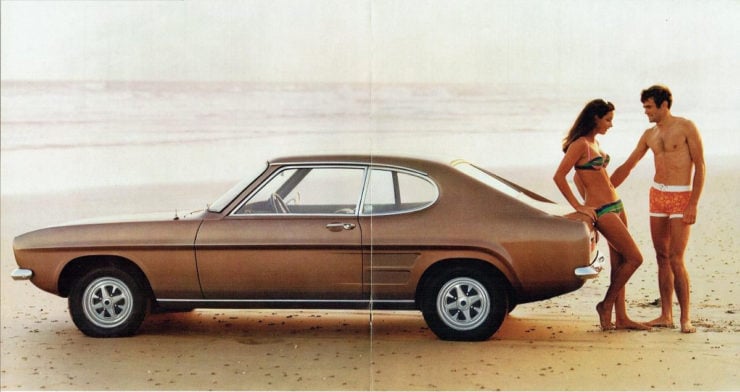

Picture Credits: Bonhams, Collecting Cars, Ford UK, H & H Auctions, and Mercury.

